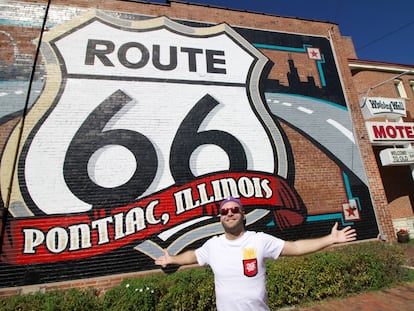The melancholy of Route 66′s last witnesses: ‘There aren’t many of us left’
The documentary ‘Almost Ghosts’ gathers the memories of three elderly people who fondly remember the glory days of the mythical highway that led to California. Everything ended along with the highway, but some refused to accept it

“We are yesterday’s people.” For today’s visitors to Route 66, once the greatest highway in the midwestern United States, time seems to have stood still in the 1950s. The gas stations, diners, painted houses, motels, the plethora of pastel and art deco colors, and billboards evoke the post-World War II years, when the automobile gained popularity among Americans. Route 66 was called the ‘Main Street of America’, and it connected Chicago to Los Angeles along nearly 4,000 kilometers enabling travel almost from coast to coast, and inland Americans to reach California (or emigrate, which they often did in years of crises and droughts).
“It took me some time to understand why the world had forgotten about us.” There is a sense of decadence. There may be tourists, but there is more desolation on what was once Route 66. There are places where some visitors stop, because the highway is not far away and they are signposted, and there are also villages that have been abandoned forever. The documentary Almost Ghosts was filmed in 2018 by Spanish director Ana Ramón Rubio with the aim of preserving the memory of the elders from the area, the last ones to remember its splendor. Not surprisingly, there is a very melancholy mood. Three neighbors in their 70s, 80s and 90s, respectively, recount their memories of when it was a frenzy, and they dwell on the moment when it suddenly ended because another stretch of highway was opened.
“I know the world outside: I’m staying here.” These people proudly declare themselves to be Rednecks, as they call the working class of the inland USA. We visited places like Seligman (Arizona, 750 inhabitants), Texola (Oklahoma, 45 neighbors) and Enrick (Oklahoma, around 1,000). We also pass through uninhabited places like Glenrio, between Texas and New Mexico, one of so many that had been somewhere and ceased to exist. And we meet Lowell Davis, the sole inhabitant of Red Oak II (Missouri), a town he refuses to leave, where he has restored abandoned houses and brought in everything he has collected from other places along the route. This 80-year-old, who says he has been around the world, explains that he wouldn’t trade his lifestyle for any other.
“Here on Saturdays the sidewalks were packed with people.” The road was originally planned in the 1920s and was not paved until 1938. Its glory days arrived in the 1950s leaving a mark on local architecture. However, the investment in infrastructure initiated by Eisenhower in the same decade led to the replacement of parts of the route with modern highways and by the 1980s, there were no sections left in use. It was decertified in 1984 and subsequently it ceased to exist. Each town, at different dates, suddenly had no customers and no livelihood. After many years of struggle, the local shopkeepers succeeded in obtaining the classification as a historic route, and the most visitable sections of the road were marked on the highway. In the late 1990s the coaches and the bikers arrived, and a way of life was born, based on selling the authenticity of something that had vanished.
“This area died because of tourism. Everyone started to want to take advantage of us.” Some of the testimonies collected here bemoan the shift from serving travelers to becoming a tourist attraction. The most vehement is Harley Russell, who runs a souvenir store where he performs an impromptu country music show when visitors stop by. He used to do this with his wife, but since she died in 2014 he finds it much harder, and cries when he recalls her. For nearly a decade and a half he only saw three customers a year; there were seasons when he slept in the store and carried a gun because looting was frequent. It was only around the turn of the century when he saw a resurgence of visitors. He is amused that someone traveled all the way from Spain to interview him.
“We’d grown up in the Great Recession, but this was even tougher.” Ángel Delgadillo is a 91-year-old practicing barber who was among those who fought to turn the old highway into a tourist destination. He speaks of it proudly: he was one of those who saved the place. The documentary is enhanced by stunning photography, which harnesses the power of the images of what appears to be a lost civilization. It is also backed by country music that fits the scenery, but not by Johnny Cash: it is the work of the Valencian Don Joaquín. There are universal messages in this film. There is the determination to carry on without looking back after a setback, the attachment to the place where people feel they belong, and the power of nostalgia, which is always somewhat deceptive because we fabricate so many memories.
“There aren’t many of us left.” Lowell Davis, his town’s only resident, passed away in 2020. Route 66 conveys magic but also sadness, and this is beautifully captured in this film. Other places in middle America never had a major thoroughfare running through them and are no better off. But these elderly people experienced the glory of the whole nation having to pass through there, and they were determined to prevent it all from being lost forever. This is not unlike what has happened in communities all over the world that have suddenly slipped away from modernity. In Spain, a route along the old N-VI highway, where there are also gas stations and abandoned hotels along 600 kilometers, is being promoted, inspired by the spirit of those fighting to preserve Route 66. These landscapes were not in Easy Rider, that’s another kind of vintage, but the elderly also have plenty to share.
Sign up for our weekly newsletter to get more English-language news coverage from EL PAÍS USA Edition
Tu suscripción se está usando en otro dispositivo
¿Quieres añadir otro usuario a tu suscripción?
Si continúas leyendo en este dispositivo, no se podrá leer en el otro.
FlechaTu suscripción se está usando en otro dispositivo y solo puedes acceder a EL PAÍS desde un dispositivo a la vez.
Si quieres compartir tu cuenta, cambia tu suscripción a la modalidad Premium, así podrás añadir otro usuario. Cada uno accederá con su propia cuenta de email, lo que os permitirá personalizar vuestra experiencia en EL PAÍS.
¿Tienes una suscripción de empresa? Accede aquí para contratar más cuentas.
En el caso de no saber quién está usando tu cuenta, te recomendamos cambiar tu contraseña aquí.
Si decides continuar compartiendo tu cuenta, este mensaje se mostrará en tu dispositivo y en el de la otra persona que está usando tu cuenta de forma indefinida, afectando a tu experiencia de lectura. Puedes consultar aquí los términos y condiciones de la suscripción digital.
More information
Últimas noticias
Most viewed
- Sinaloa Cartel war is taking its toll on Los Chapitos
- Oona Chaplin: ‘I told James Cameron that I was living in a treehouse and starting a permaculture project with a friend’
- Reinhard Genzel, Nobel laureate in physics: ‘One-minute videos will never give you the truth’
- Why the price of coffee has skyrocketed: from Brazilian plantations to specialty coffee houses
- Silver prices are going crazy: This is what’s fueling the rally











































